Biocompatibility and Post-Marketing Surveillance Study of Emollient Plus Medical Device Cream Containing Oligofructans from Ophiopogon japonicus and Acetyl Heptapeptide-4 in Atopic Dermatitis Skin Care
Abstract
1. Introduction
2. Materials and Methods
2.1. Medical Device Cream Characteristics
2.2. In Vitro Safety Assessment of Medical Device Emollient Cream
2.2.1. Direct MTT Assay
2.2.2. Indirect Cytotoxicity Assessment with Agarose Overlay
2.2.3. Irritation Potential of Medical Device Emollient Cream
2.3. Patients’ Self-Evaluation of Product Efficacy
2.4. Dermatological Assessment of Product Efficacy
3. Results
3.1. In Vitro Safety Assessment of Medical Device Emollient Cream
3.2. Patients’ Characteristics in Self-Evaluation Product Efficacy
3.3. Patients’ Self-Evaluation of Product Efficacy
3.4. Product Characteristics Assessed by Users
3.5. Dermatological Assessment of Product Efficacy
4. Discussion
Supplementary Materials
Author Contributions
Funding
Institutional Review Board Statement
Informed Consent Statement
Data Availability Statement
Acknowledgments
Conflicts of Interest
References
- DaVeiga, S.P. Epidemiology of Atopic Dermatitis: A Review. Allergy Asthma Proc. 2012, 33, 227–234. [Google Scholar] [CrossRef] [PubMed]
- Montero-Vilchez, T.; Segura-Fernández-nogueras, M.V.; Pérez-Rodríguez, I.; Soler-Gongora, M.; Martinez-Lopez, A.; Fernández-González, A.; Molina-Leyva, A.; Arias-Santiago, S. Skin Barrier Function in Psoriasis and Atopic Dermatitis: Transepidermal Water Loss and Temperature as Useful Tools to Assess Disease Severity. J. Clin. Med. 2021, 10, 359. [Google Scholar] [CrossRef] [PubMed]
- Emmert, H.; Baurecht, H.; Thielking, F.; Stölzl, D.; Rodriguez, E.; Harder, I.; Proksch, E.; Weidinger, S. Stratum Corneum Lipidomics Analysis Reveals Altered Ceramide Profile in Atopic Dermatitis Patients across Body Sites with Correlated Changes in Skin Microbiome. Exp. Dermatol. 2021, 30, 1398–1408. [Google Scholar] [CrossRef] [PubMed]
- Demessant-Flavigny, A.L.; Connétable, S.; Kerob, D.; Moreau, M.; Aguilar, L.; Wollenberg, A. Skin Microbiome Dysbiosis and the Role of Staphylococcus Aureus in Atopic Dermatitis in Adults and Children: A Narrative Review. J. Eur. Acad. Dermatol. Venereol. 2023, 37, 3–17. [Google Scholar] [CrossRef]
- Danby, S.G.; Andrew, P.V.; Kay, L.J.; Pinnock, A.; Chittock, J.; Brown, K.; Williams, S.F.; Cork, M.J. Enhancement of Stratum Corneum Lipid Structure Improves Skin Barrier Function and Protects against Irritation in Adults with Dry, Eczema-Prone Skin. Br. J. Dermatol. 2022, 186, 875–886. [Google Scholar] [CrossRef] [PubMed]
- Czarnowicki, T.; He, H.; Krueger, J.G.; Guttman-Yassky, E. Atopic Dermatitis Endotypes and Implications for Targeted Therapeutics. J. Allergy Clin. Immunol. 2019, 143, 1–11. [Google Scholar] [CrossRef] [PubMed]
- Goh, M.S.Y.; Yun, J.S.W.; Su, J.C. Management of Atopic Dermatitis: A Narrative Review. Med. J. Aust. 2022, 216, 587–593. [Google Scholar] [CrossRef] [PubMed]
- Grafanaki, K.; Bania, A.; Kaliatsi, E.G.; Vryzaki, E.; Vasilopoulos, Y.; Georgiou, S. The Imprint of Exposome on the Development of Atopic Dermatitis across the Lifespan: A Narrative Review. J. Clin. Med. 2023, 12, 2180. [Google Scholar] [CrossRef]
- Xu, D.; Stengel, R.; Sun, P. Effectiveness of Emollients in the Prevention of Atopic Dermatitis in Infants: A Meta-Analysis. Dermatology 2022, 238, 711–716. [Google Scholar] [CrossRef]
- Müller, S.; Maintz, L.; Bieber, T. Treatment of Atopic Dermatitis: Recently Approved Drugs and Advanced Clinical Development Programs. Allergy Eur. J. Allergy Clin. Immunol. 2024, 79, 1501–1515. [Google Scholar] [CrossRef]
- Nicogossian, J.; Héas, S.; Thénié, C.; Noel, M.; Misery, L.; Barbarot, S.; Martin Juchat, F. Questions a Patient with Moderate to Severe Atopic Dermatitis Would like to Be Asked: Data from a Qualitative Study Conducted by Anthropologists. In JEADV Clinical Practice; Wiley: Hoboken, NJ, USA, 2024. [Google Scholar] [CrossRef]
- Amerio, P.; Ferrucci, S.M.; Galluzzo, M.; Napolitano, M.; Narcisi, A.; Levi, A.; Di Fino, S.; Palladino, C.; Patruno, C.; Rossi, M. A Multidisciplinary Approach Is Beneficial in Atopic Dermatitis. Dermatol. Ther. 2024, 14, 1443–1455. [Google Scholar] [CrossRef]
- Allen, O.G.E.; Macneill, S.; Ridd, M.J. Parent Satisfaction with Lotion, Cream, Gel and Ointment Emollient Types: Secondary Analysis of the Best Emollients for Eczema Study. Clin. Exp. Dermatol. 2024, 49, 573–577. [Google Scholar] [CrossRef] [PubMed]
- Wollenberg, A.; Kinberger, M.; Arents, B.; Aszodi, N.; Avila Valle, G.; Barbarot, S.; Bieber, T.; Brough, H.A.; Calzavara Pinton, P.; Christen-Zäch, S.; et al. European Guideline (EuroGuiDerm) on Atopic Eczema—Part II: Non-Systemic Treatments and Treatment Recommendations for Special AE Patient Populations. J. Eur. Acad. Dermatol. Venereol. 2022, 36, 1904–1926. [Google Scholar] [CrossRef]
- Patel, N.; Feldman, S. Adherence in Atopic Dermatitis. Adv. Exp. Med. Biol. 2024, 1447, 169–190. [Google Scholar] [CrossRef] [PubMed]
- Sokolova, A.; Smith, S.D. Factors Contributing to Poor Treatment Outcomes in Childhood Atopic Dermatitis. Aust. J. Dermatol. 2015, 56, 252–257. [Google Scholar] [CrossRef]
- Salvati, L.; Cosmi, L.; Annunziato, F. Molecular Sciences Review From Emollients to Biologicals: Targeting Atopic Dermatitis. Int. J. Mol. Sci. 2021, 22, 10381. [Google Scholar] [CrossRef]
- Lachapelle, J.M.; Gimenez-Arnau, A.; Metz, M.; Peters, J.; Proksch, E. Best Practices, New Perspectives and the Perfect Emollient: Optimizing the Management of Contact Dermatitis. J. Dermatol. Treat. 2018, 29, 241–251. [Google Scholar] [CrossRef] [PubMed]
- Quadri, M.; Lotti, R.; Bonzano, L.; Ciardo, S.; Guanti, M.B.; Pellacani, G.; Pincelli, C.; Marconi, A. A Novel Multi-Action Emollient plus Cream Improves Skin Barrier Function in Patients with Atopic Dermatitis: In Vitro and Clinical Evidence. Skin Pharmacol. Physiol. 2021, 34, 8–18. [Google Scholar] [CrossRef] [PubMed]
- Patsatsi, A.; Vakirlis, E.; Kanelleas, A.; Stefanaki, I.; Kemanetzi, C.; Loizidis, C.; Pasmatzi, E. Effect of a Novel “Emollient plus” Formulation on Mild-to-Severe Atopic Dermatitis and Other Dry Skin-Related Diseases as Monotherapy or Adjunctive Therapy: An Observational Study on Efficacy, Tolerance and Quality of Life in Adult Patients. Eur. J. Dermatol. 2023, 33, 137–146. [Google Scholar] [CrossRef]
- Hrestak, D.; Matijašić, M.; Paljetak, H.Č.; Drvar, D.L.; Hadžavdić, S.L.; Perić, M. Skin Microbiota in Atopic Dermatitis. Int. J. Mol. Sci. 2022, 23, 3503. [Google Scholar] [CrossRef]
- Kong, H.H.; Oh, J.; Deming, C.; Conlan, S.; Grice, E.A.; Beatson, M.A.; Nomicos, E.; Polley, E.C.; Komarow, H.D.; Mullikin, J.; et al. Temporal Shifts in the Skin Microbiome Associated with Disease Flares and Treatment in Children with Atopic Dermatitis. Genome Res. 2012, 22, 850–859. [Google Scholar] [CrossRef] [PubMed]
- Condrò, G.; Guerini, M.; Castello, M.; Perugini, P. Acne Vulgaris, Atopic Dermatitis and Rosacea: The Role of the Skin Microbiota—A Review. Biomedicines 2022, 10, 2523. [Google Scholar] [CrossRef] [PubMed]
- Hwang, J.; Thompson, A.; Jaros, J.; Blackcloud, P.; Hsiao, J.; Shi, V.Y. Updated Understanding of Staphylococcus aureus in Atopic Dermatitis: From Virulence Factors to Commensals and Clonal Complexes. Exp. Dermatol. 2021, 30, 1532–1545. [Google Scholar] [CrossRef] [PubMed]
- Chung, E.J.; Luo, C.H.; Thio, C.L.P.; Chang, Y.J. Immunomodulatory Role of Staphylococcus Aureus in Atopic Dermatitis. Pathogens 2022, 11, 422. [Google Scholar] [CrossRef] [PubMed]
- EN ISO 10993-5:2009; Biological Evaluation of Medical Devices. Part 5: Tests for In Vitro Cytotoxicity. International Organization for Standardization: Geneva, Switzerland, 2009.
- EN ISO 10993-12:2012; Biological Evaluation of Medical Devices—Part 12: Sample Preparation and Reference Materials. International Organization for Standardization: Geneva, Switzerland, 2012.
- OECD. Test No. 439 In Vitro Skin Irritation: Reconstructed Human Epidermis Test Method. In OECD Guidelines for the Testing of Chemicals; OECD: Paris, France, 2021. [Google Scholar]
- EN ISO 10993-23:2021; Biological Evaluation of Medical Devices—Part 23: Tests for Irritation. International Organization for Standardization: Geneva, Switzerland, 2021.
- Pinto, J.R.; Monteiro, E.; Silva, S.A.; Holsback, V.S.S.; Leonardi, G.R. Skin occlusive performance: Sustainable alternatives for petrolatum in skincare formulations. J. Cosmet. Dermatol. 2022, 21, 4775–4780. [Google Scholar] [CrossRef] [PubMed]
- Hebert, A.A.; Rippke, F.; Weber, T.M.; Nicol, N.H. Efficacy of Nonprescription Moisturizers for Atopic Dermatitis: An Updated Review of Clinical Evidence. Am. J. Clin. Dermatol. 2020, 21, 641–655. [Google Scholar] [CrossRef] [PubMed]
- Poljšak, N.; Kočevar Glavač, N. Vegetable Butters and Oils as Therapeutically and Cosmetically Active Ingredients for Dermal Use: A Review of Clinical Studies. Front. Pharmacol. 2022, 13, 868461. [Google Scholar] [CrossRef] [PubMed]
- Lin, L.; Allemekinders, H.; Dansby, A.; Campbell, L.; Durance-Tod, S.; Berger, A.; Jones, P.J. Evidence of Health Benefits of Canola Oil. Nutr. Rev. 2013, 71, 370–385. [Google Scholar] [CrossRef] [PubMed]
- Oomah, B.D.; Busson, M.; Godfrey, D.V.; Drover, J.C.G. Characteristics of Hemp (Cannabis sativa L.) Seed Oil. Food Chem. 2002, 76, 33–43. [Google Scholar] [CrossRef]
- Şeker, M.; Esen, Ö. The Effect of Hemp Seed Oil on Skin and Soap Performance. Int. J. Life Sci. Biotechnol. 2021, 4, 420–438. [Google Scholar] [CrossRef]
- Callaway, J.C. Hempseed as a Nutritional Resource: An Overview. Euphytica 2004, 140, 65–72. [Google Scholar]
- Madison, K.C. Barrier Function of the Skin: “La Raison d’Être” of the Epidermis. J. Investig. Dermatol. 2003, 121, 231–241. [Google Scholar] [CrossRef]
- Wertz, P.W. Lipids and Barrier Function of the Skin. Acta Derm.-Venereol. 2000, 80 Suppl. S208, 7–11. [Google Scholar]
- Balić, A.; Vlašić, D.; Žužul, K.; Marinović, B.; Mokos, Z.B. Omega-3 versus Omega-6 Polyunsaturated Fatty Acids in the Prevention and Treatment of Inflammatory Skin Diseases. Int. J. Mol. Sci. 2020, 21, 741. [Google Scholar] [CrossRef] [PubMed]
- Simard, M.; Tremblay, A.; Morin, S.; Martin, C.; Julien, P.; Fradette, J.; Flamand, N.; Pouliot, R. α-Linolenic Acid and Linoleic Acid Modulate the Lipidome and the Skin Barrier of a Tissue-Engineered Skin Model. Acta Biomater. 2022, 140, 261–274. [Google Scholar] [CrossRef] [PubMed]
- Blaess, M.; Deigner, H.P. Derailed Ceramide Metabolism in Atopic Dermatitis (AD): A Causal Starting Point for a Personalized (Basic) Therapy. Int. J. Mol. Sci. 2019, 20, 3967. [Google Scholar] [CrossRef] [PubMed]
- Zhang, Y.; Heinemann, N.; Rademacher, F.; Darvin, M.E.; Raab, C.; Keck, C.M.; Vollert, H.; Fluhr, J.W.; Gläser, R.; Harder, J.; et al. Skin Care Product Rich in Antioxidants and Anti-Inflammatory Natural Compounds Reduces Itching and Inflammation in the Skin of Atopic Dermatitis Patients. Antioxidants 2022, 11, 1071. [Google Scholar] [CrossRef]
- Bertino, L.; Guarneri, F.; Cannavò, S.P.; Casciaro, M.; Pioggia, G.; Gangemi, S. Oxidative Stress and Atopic Dermatitis. Antioxidants 2020, 9, 196. [Google Scholar] [CrossRef] [PubMed]
- Nugroho, W.T.; Dong, Y.; Pramanik, A.; Zhang, Z.; Ramakrishna, S. Co-Influence of Nanofiller Content and 3D Printing Parameters on Mechanical Properties of Thermoplastic Polyurethane (TPU)/Halloysite Nanotube (HNT) Nanocomposites. Nanomaterials 2023, 13, 1975. [Google Scholar] [CrossRef] [PubMed]
- Tsakok, T.; Woolf, R.; Smith, C.H.; Weidinger, S.; Flohr, C. Atopic Dermatitis: The Skin Barrier and Beyond. Br. J. Dermatol. 2019, 180, 464–474. [Google Scholar] [CrossRef] [PubMed]
- Goleva, E.; Berdyshev, E.; Leung, D.Y.M. Epithelial Barrier Repair and Prevention of Allergy. J. Clin. Investig. 2019, 129, 1463–1474. [Google Scholar] [CrossRef]
- Somjorn, P.; Kamanamool, N.; Kanokrungsee, S.; Rojhirunsakool, S.; Udompataikul, M. A Cream Containing Linoleic Acid, 5% Dexpanthenol and Ceramide in the Treatment of Atopic Dermatitis. Asian Pac. J. Allergy Immunol. 2021, 10, 1–7. [Google Scholar] [CrossRef]
- Berkers, T.; Visscher, D.; Gooris, G.S.; Bouwstra, J.A. Topically Applied Ceramides Interact with the Stratum Corneum Lipid Matrix in Compromised Ex Vivo Skin. Pharm. Res. 2018, 35, 48. [Google Scholar] [CrossRef] [PubMed]
- Sahle, F.F.; Metz, H.; Wohlrab, J.; Neubert, R.H.H. Polyglycerol Fatty Acid Ester Surfactant-Based Microemulsions for Targeted Delivery of Ceramide AP into the Stratum Corneum: Formulation, Characterisation, in Vitro Release and Penetration Investigation. Eur. J. Pharm. Biopharm. 2012, 82, 139–150. [Google Scholar] [CrossRef]
- Makino, T.; Hamanaka, M.; Yamashita, H.; Mizukami, H. Effect of Bakumijiogan, an Herbal Formula in Traditional Chinese Medicine, on Atopic Dermatitis-like Skin Lesions Induced by Mite Antigen in NC/Jic Mice. Biol. Pharm. Bull. 2008, 31, 2108–2113. [Google Scholar] [CrossRef][Green Version]
- Mainzer, C.; Le Guillou, M.; Vyumvuhore, R.; Chadoutaud, B.; Bordes, S.; Closs, B. Clinical Efficacy of Oligofructans from Ophiopogon japonicus in Reducing Atopic Dermatitis Flare-Ups in Caucasian Patients. Acta Derm. Venereol. 2019, 99, 858–864. [Google Scholar] [CrossRef] [PubMed]
- Zelenkova, H.; Kerob, D.; Salah, S.; Demessant-Flavigny, A.L. Impact of Daily Use of Emollient ‘plus’ on Corticosteroid Consumption in Patients with Atopic Dermatitis: An Open, Randomized Controlled Study. J. Eur. Acad. Dermatol. Venereol. 2023, 37, 27–34. [Google Scholar] [CrossRef] [PubMed]
- Staiano, S. Fensebiome peptide—Riconnettiti con le tue origini per avere una pelle più sana. Cosmet. Technol. Riv. Sci. Cosmetol. 2019, 22, 70–73. [Google Scholar]
- Pasikowska-Piwko, M.; Zapotoczna, M.; Dębowska, R.; Zyglińska, I.; Cieścińska, C.; Załuska, A.; Kołaczek, A.; Rajkowska, K.; Otlewska, A.; Rogiewicz, K.; et al. Safety and tolerability of two emollients containing complex targeting Staphylococcus aureus biofilm formation. In Proceedings of the European Academy of Dermatology and Venereology Congress, Milan, Italy, 7–10 September 2022. [Google Scholar]
- Kunkiel, K.; Natkańska, A.; Nędzi, M.; Zawadzka-Krajewska, A.; Feleszko, W. Patients’ Preferences of Leave-on Emollients: A Survey on Patients with Atopic Dermatitis. J. Dermatol. Treat. 2022, 33, 1143–1145. [Google Scholar] [CrossRef]
- Xu, S.; Kwa, M.; Lohman, M.E.; Evers-Meltzer, R.; Silverberg, J.I. Consumer Preferences, Product Characteristics, and Potentially Allergenic Ingredients in Best-Selling Moisturizers. JAMA Dermatol. 2017, 153, 1099–1105. [Google Scholar] [CrossRef]
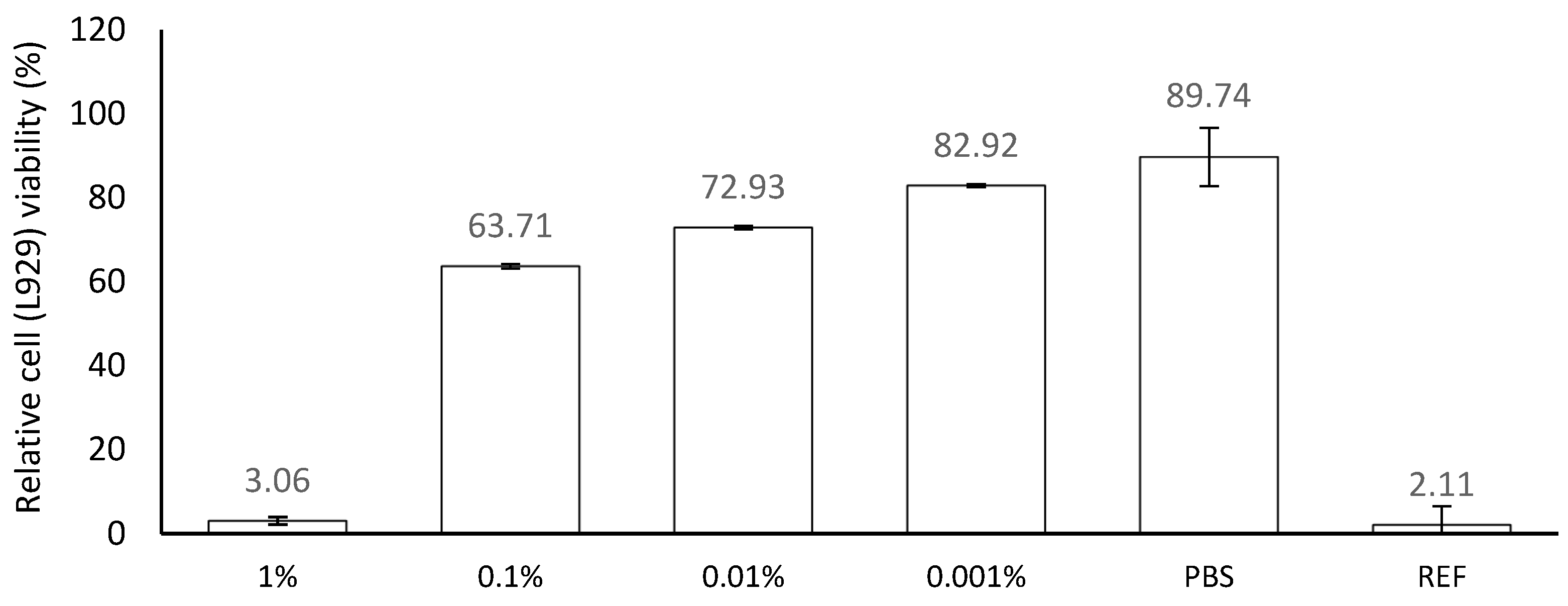
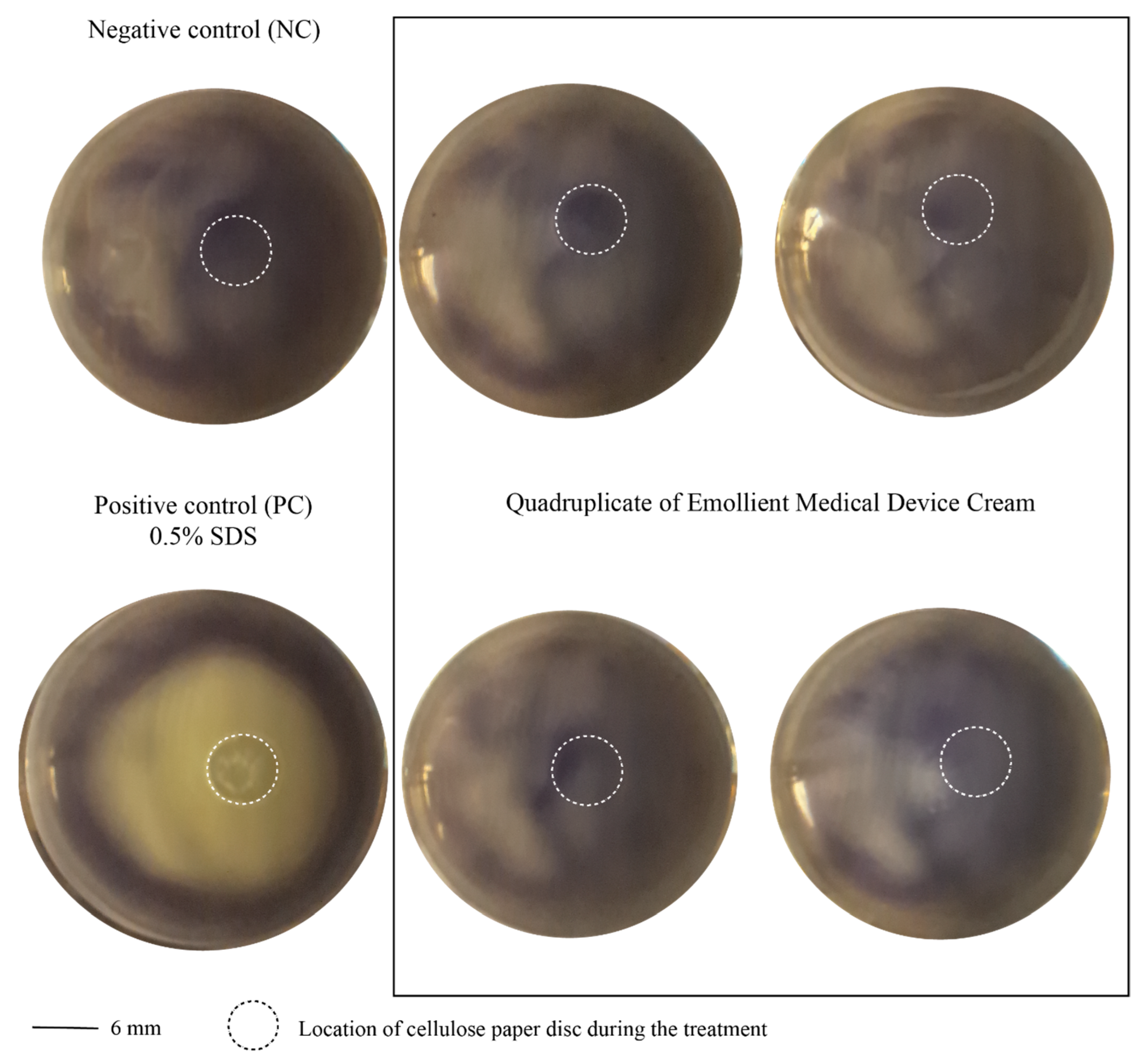
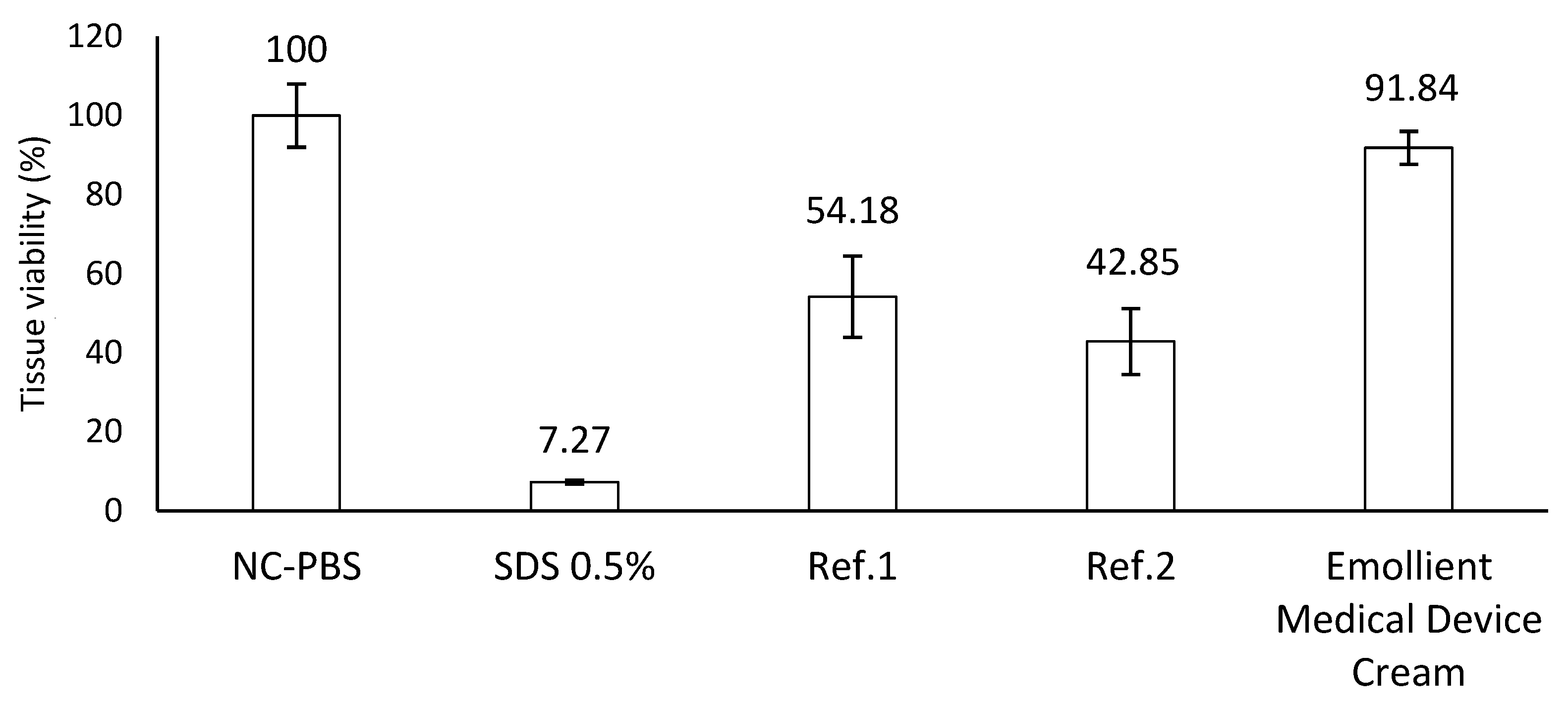
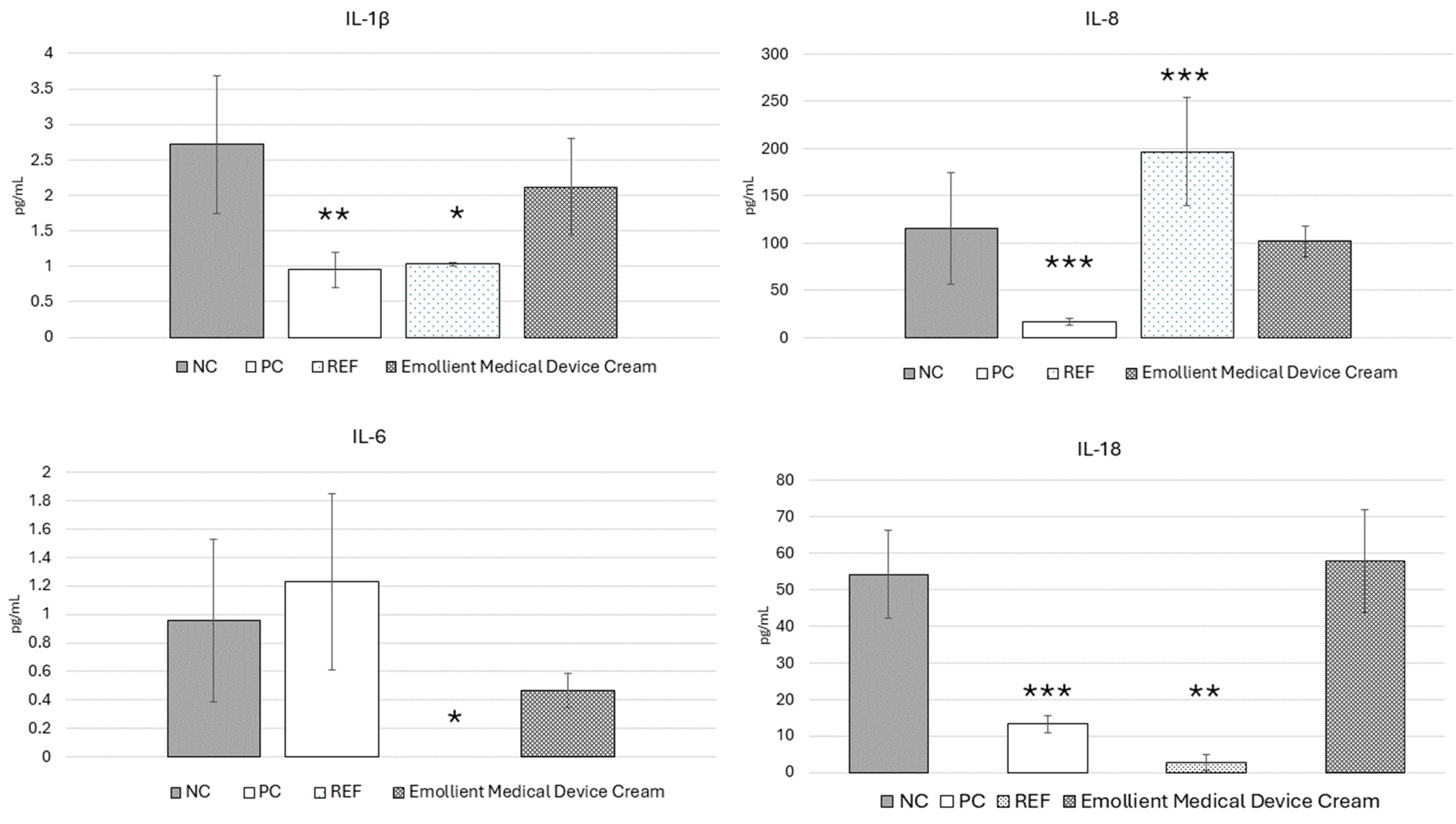


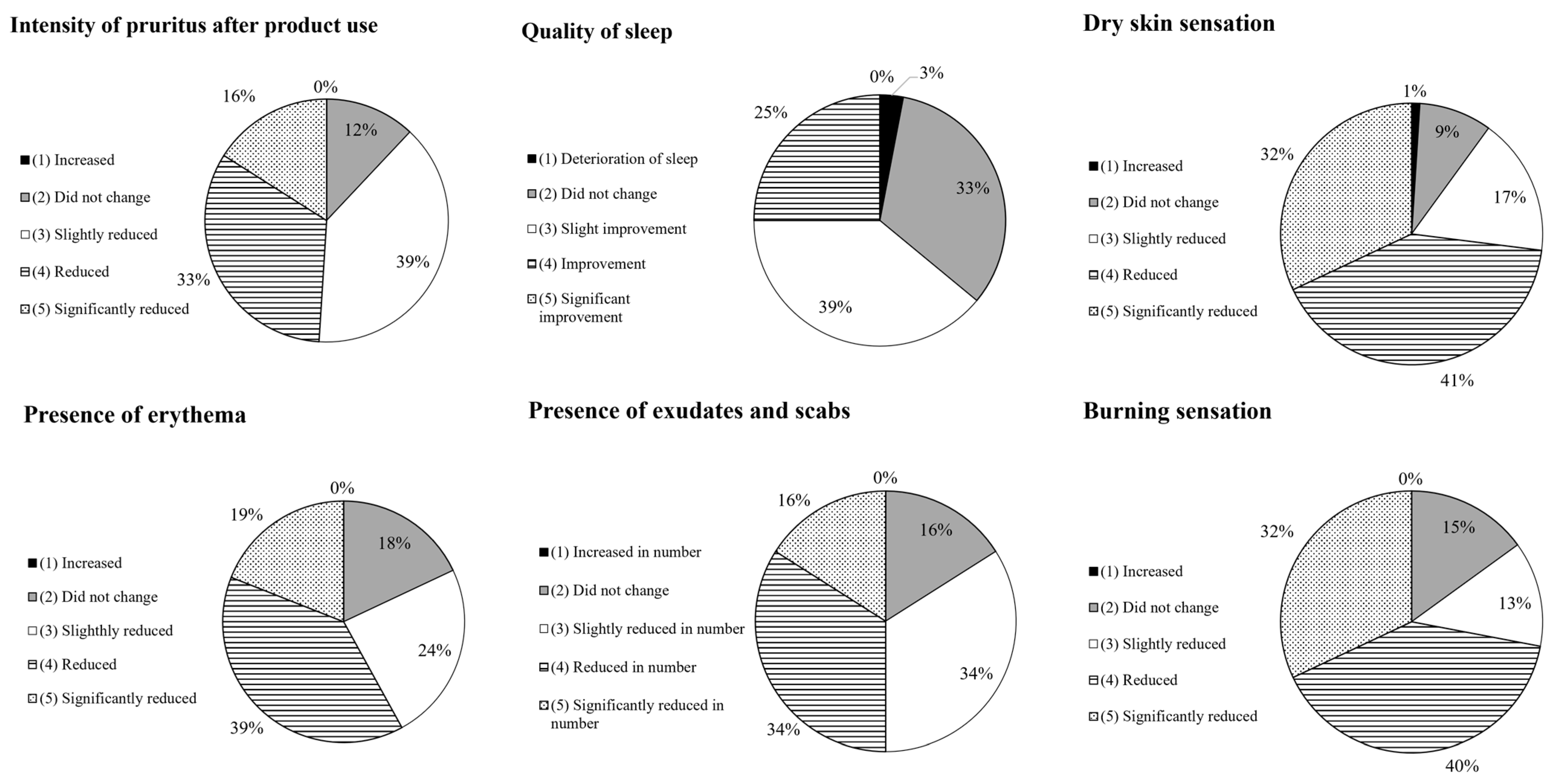
| Type of Skin Lesion | Dermatological Evaluation in Analogue Scale (Local SCORAD) (n = 24) | ||
|---|---|---|---|
| Before | After | Change [%] | |
| Erythema | 2.33 | 1.56 | −33.0 |
| Oedema | 2.11 | 1.56 | −26.1 |
| Exudates and scabs | 1.56 | 0.78 | −50.0 |
| Breaks caused by scratching | 2.00 | 1.56 | −22.0 |
| Thickening of the skin | 1.89 | 1.44 | −23.8 |
| Pruritus (subjective) | 5.5 | 3.25 | −40.9 |
| Sleep disorders (subjective) | 3.88 | 3.25 | −16.2 |
Disclaimer/Publisher’s Note: The statements, opinions and data contained in all publications are solely those of the individual author(s) and contributor(s) and not of MDPI and/or the editor(s). MDPI and/or the editor(s) disclaim responsibility for any injury to people or property resulting from any ideas, methods, instructions or products referred to in the content. |
© 2024 by the authors. Licensee MDPI, Basel, Switzerland. This article is an open access article distributed under the terms and conditions of the Creative Commons Attribution (CC BY) license (https://creativecommons.org/licenses/by/4.0/).
Share and Cite
Rachalewski, M.; Pasikowska-Piwko, M.; Dębowska, R.; Marczak, I.; Lendzion, K.; Godziątkowski, H.; Czarnomysy, R.; Rogiewicz, K.; Eris, I. Biocompatibility and Post-Marketing Surveillance Study of Emollient Plus Medical Device Cream Containing Oligofructans from Ophiopogon japonicus and Acetyl Heptapeptide-4 in Atopic Dermatitis Skin Care. Cosmetics 2024, 11, 136. https://doi.org/10.3390/cosmetics11040136
Rachalewski M, Pasikowska-Piwko M, Dębowska R, Marczak I, Lendzion K, Godziątkowski H, Czarnomysy R, Rogiewicz K, Eris I. Biocompatibility and Post-Marketing Surveillance Study of Emollient Plus Medical Device Cream Containing Oligofructans from Ophiopogon japonicus and Acetyl Heptapeptide-4 in Atopic Dermatitis Skin Care. Cosmetics. 2024; 11(4):136. https://doi.org/10.3390/cosmetics11040136
Chicago/Turabian StyleRachalewski, Michał, Monika Pasikowska-Piwko, Renata Dębowska, Iwona Marczak, Karolina Lendzion, Hubert Godziątkowski, Robert Czarnomysy, Katarzyna Rogiewicz, and Irena Eris. 2024. "Biocompatibility and Post-Marketing Surveillance Study of Emollient Plus Medical Device Cream Containing Oligofructans from Ophiopogon japonicus and Acetyl Heptapeptide-4 in Atopic Dermatitis Skin Care" Cosmetics 11, no. 4: 136. https://doi.org/10.3390/cosmetics11040136
APA StyleRachalewski, M., Pasikowska-Piwko, M., Dębowska, R., Marczak, I., Lendzion, K., Godziątkowski, H., Czarnomysy, R., Rogiewicz, K., & Eris, I. (2024). Biocompatibility and Post-Marketing Surveillance Study of Emollient Plus Medical Device Cream Containing Oligofructans from Ophiopogon japonicus and Acetyl Heptapeptide-4 in Atopic Dermatitis Skin Care. Cosmetics, 11(4), 136. https://doi.org/10.3390/cosmetics11040136







